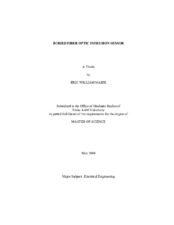| dc.description.abstract | A distributed fiber optic intrusion sensor capable of detecting intruders from the pressure of their weight on the earth's surface was investigated in the laboratory and in field tests. The presence of an intruder above or in proximity to the buried sensor induces a phase shift in light propagating along the fiber which allows for the detection and localization of intrusions. Through the use of an ultra-stable erbium-doped fiber laser and phase sensitive optical time domain reflectometry, disturbances were monitored in long (several km) lengths of optical fiber. Narrow linewidth and low frequency drift in the laser were achieved through a combination of optical feedback and insulation of the laser cavity against environmental effects. The frequency drift of the laser, characterized using an all-fiber Mach Zehnder interferometer, was found to be less than 1 MHz/min, as required for operation of the intrusion detection system. Intrusions were simulated in a laboratory setting using a piezoelectric transducer to produce a controllable optical phase shift at the 2 km point of a 12 km path length. Interrogation of the distributed sensor was accomplished by repetitively gating light pulses from the stable laser into the sensing fiber. By monitoring the Rayleigh backscattered light with a photodetector and comparing traces with and without an induced phase shift, the phase disturbances were detected and located. Once the feasibility of such a sensor was proven in the laboratory, the experimental set up was transferred to Texas A&M's Riverside Campus. At the test site, approximately 40 meters of fiber optic cable were buried in a triangle perimeter and then spliced into the 12 km path length which was housed inside the test facility. Field tests were conducted producing results comparable to those found in the laboratory. Intrusions over this buried fiber were detectable on the φ-OTDR trace and could be localized to the intrusion point. This type of sensor has the potential benefits of heightened sensitivity, covertness, and greatly reduced cost over the conventional seismic, acoustic, infrared, magnetic, and fiber optic sensors for monitoring long (multi-km) perimeters. | en |


